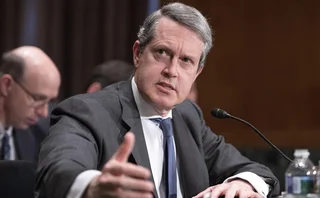
Strict hedge fund rules in Korea hinder market growth
The newly born Korean hedge fund market has made swift progress – but regulatory obstruction makes it difficult for funds to get both clients and prime brokers

Following a three-year gestation period, the Korean hedge fund market burst into life on December 23, 2011. By the end of February 2012, 12 Korean managers had registered 17 funds with a total of $500million of assets under management – and market observers are bullish there is much more to come.
The Korea Institute of Finance estimates that total assets under management (AUM) could hit 13 trillion won ($11.5 billon) in the next two years – on a par with the Japanese market, which has had two
Only users who have a paid subscription or are part of a corporate subscription are able to print or copy content.
To access these options, along with all other subscription benefits, please contact info@risk.net or view our subscription options here: http://subscriptions.risk.net/subscribe
You are currently unable to print this content. Please contact info@risk.net to find out more.
You are currently unable to copy this content. Please contact info@risk.net to find out more.
Copyright Infopro Digital Limited. All rights reserved.
As outlined in our terms and conditions, https://www.infopro-digital.com/terms-and-conditions/subscriptions/ (point 2.4), printing is limited to a single copy.
If you would like to purchase additional rights please email info@risk.net
Copyright Infopro Digital Limited. All rights reserved.
You may share this content using our article tools. As outlined in our terms and conditions, https://www.infopro-digital.com/terms-and-conditions/subscriptions/ (clause 2.4), an Authorised User may only make one copy of the materials for their own personal use. You must also comply with the restrictions in clause 2.5.
If you would like to purchase additional rights please email info@risk.net
More on Regulation
Capital neutrality key to completing Basel III, says Quarles
Former Republican Fed vice-chair thinks Hill or Bowman could help revive stalled prudential rules
Review of 2024: as markets took a breather, firms switched focus
In the absence of major crises and rules deadlines, financial firms revamped strategy, services and practices
Dora flood pitches banks against vendors
Firms ask vendors for late addendums sometimes unrelated to resiliency, requiring renegotiation
Swiss report fingers Finma on Credit Suisse capital ratio
Parliament says bank would have breached minimum requirements in 2022 without regulatory filter
‘It’s not EU’: Do government bond spreads spell eurozone break-up?
Divergence between EGB yields is in the EU’s make-up; only a shared risk architecture can reunite them
CFTC weighs third-party risk rules for CCPs
Clearing houses could be required to formally identify and monitor critical vendors
Why there is no fence in effective regulatory relationships
A chief risk officer and former bank supervisor says regulators and regulated are on the same side
Snap! Derivatives reports decouple after Emir Refit shake-up
Counterparties find new rules have led to worse data quality, threatening regulators’ oversight of systemic risk







